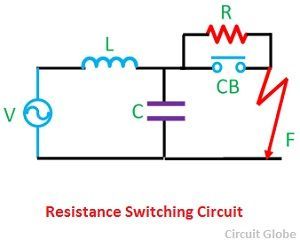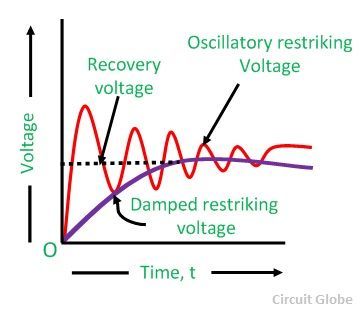A fixed connection of resistance in parallel with the contact space or arc is called the resistance switching. Resistance switching is employed in circuit breakers having a high post zero resistance of contact space. The resistance switching is mainly used for reducing the restriking voltage and the transient voltage surge.
Severe voltage occurs in the system because of two reasons, firstly because of the breaking of low voltage current, and secondly because of the breaking of capacitive current. The severe voltage may endanger the operation of the system. It can be avoided by using resistance switching (by connecting the resistor across the contacts of the circuit breaker).

When the fault occurs, the contacts of the circuit breaker are open, and an arc is struck between the contacts. With the arc shunted by the resistance R, a part of arc current is diverted through the resistance. This results in the decreases of arc current and an increase in the rate of deionization of the arc path.
Thus, the arc resistance is increased, leading to the further increase in current through the shunt resistance R. This builds up process continue until the current becomes so small that it fails to maintain the arc shown in the figure below. Now the arc is extinguished, and the circuit breaker gets interrupted.
 Alternatively, the resistance may be automatically switched in by transference of the arc from the main contacts to the probe contact as in the case of an axial blast circuit breaker, the time required for this action is very small. Having the arc path substituted by a metallic path, the current flowing through the resistance is limited and then easily broken.
Alternatively, the resistance may be automatically switched in by transference of the arc from the main contacts to the probe contact as in the case of an axial blast circuit breaker, the time required for this action is very small. Having the arc path substituted by a metallic path, the current flowing through the resistance is limited and then easily broken.
The shunt resistor also helps in limiting the oscillatory growth of restriking voltage transients. It can be proved mathematically that the natural frequency (fn) of oscillations of the circuit shown is given as
 To sum up, resistor across the circuit breaker contacts may be used to perform any one or more of the following functions.
To sum up, resistor across the circuit breaker contacts may be used to perform any one or more of the following functions.
- It reduces the RRRV ( Rate of Rising of Restriking Voltage ) burden on the circuit breaker.
- It reduces the high-frequency restriking voltage transients during switching out inductive or capacitive loads.
- In a multi-break circuit breaker, it helps in distributing the transient recovery voltage more uniformly across the contact gaps.
The resistance switching is not required in the plan circuit breaker because their contact space is low.

simple and clear cut explanation. thank you